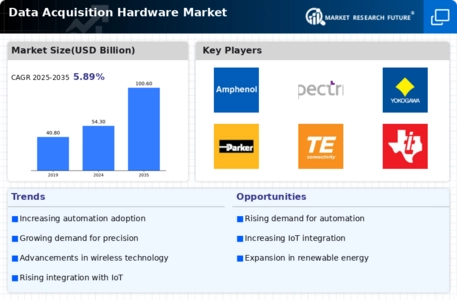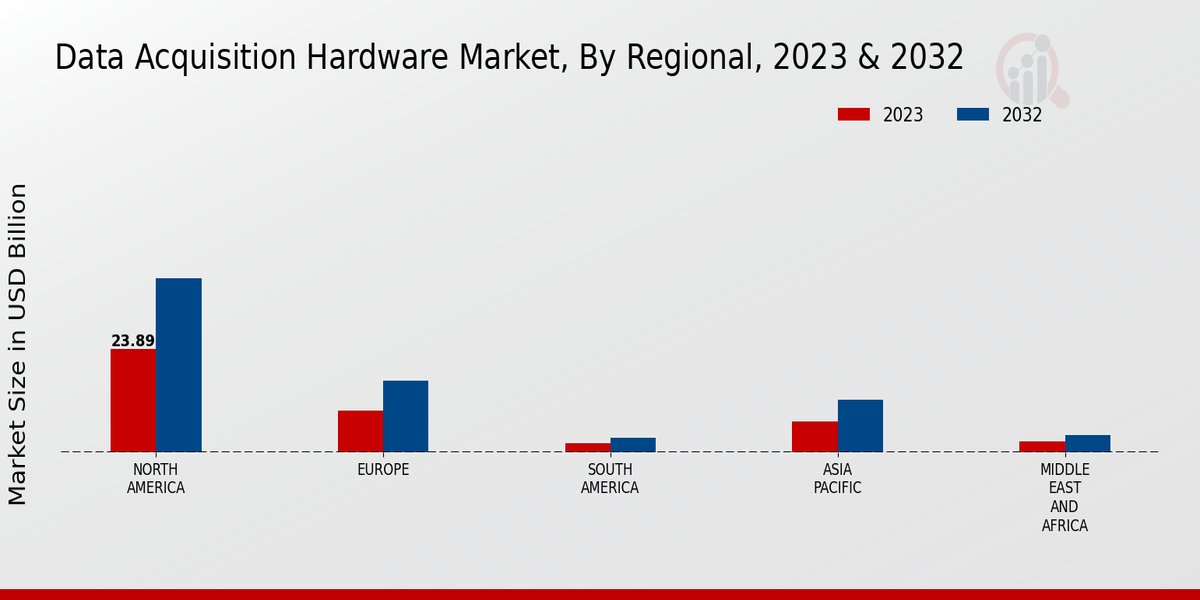Emerging Markets
The expansion of emerging markets presents a substantial opportunity for the Global Data Acquisition Hardware Market Industry. Countries in Asia-Pacific, Latin America, and Africa are witnessing rapid industrialization and technological adoption, leading to increased investments in data acquisition systems. As these regions develop their infrastructure and industries, the demand for reliable data collection and analysis tools is likely to grow. This trend is particularly evident in sectors such as agriculture, where data acquisition hardware is used for precision farming. The potential for growth in these emerging markets is expected to contribute significantly to the overall market expansion.
Regulatory Compliance
Regulatory compliance requirements across various industries are shaping the Global Data Acquisition Hardware Market Industry. Organizations are mandated to adhere to strict standards regarding data collection, storage, and reporting, particularly in sectors like pharmaceuticals and environmental monitoring. Data acquisition hardware plays a vital role in ensuring compliance by providing accurate and reliable data necessary for audits and reporting. As regulations become more stringent, the demand for compliant data acquisition systems is expected to rise. This trend not only drives market growth but also emphasizes the importance of investing in high-quality data acquisition solutions to meet regulatory standards.
Increasing Data Volume
The exponential growth of data generated across various sectors is a critical driver for the Global Data Acquisition Hardware Market Industry. With the advent of big data analytics, organizations are compelled to invest in robust data acquisition systems to capture, store, and analyze vast amounts of information. This trend is particularly prominent in sectors such as finance, healthcare, and telecommunications, where data-driven decision-making is paramount. As organizations seek to harness the power of data, the demand for advanced data acquisition hardware is likely to surge. This increasing data volume is a key factor contributing to the market's anticipated growth, reaching 54.3 USD Billion in 2024.
Market Growth Projections
The Global Data Acquisition Hardware Market Industry is poised for substantial growth, with projections indicating a market size of 54.3 USD Billion in 2024 and an anticipated increase to 100.6 USD Billion by 2035. This growth trajectory reflects a compound annual growth rate (CAGR) of 5.77% from 2025 to 2035, highlighting the increasing reliance on data acquisition technologies across various sectors. The market's expansion is driven by factors such as technological advancements, rising demand for automation, and the growing volume of data generated globally. These projections underscore the importance of data acquisition hardware in supporting the evolving needs of industries worldwide.
Technological Advancements
The Global Data Acquisition Hardware Market Industry is experiencing rapid technological advancements that enhance data collection and processing capabilities. Innovations such as high-speed data converters, wireless communication technologies, and advanced sensors are driving the market forward. For instance, the integration of Internet of Things (IoT) devices allows for real-time data acquisition, which is crucial in sectors like manufacturing and healthcare. These advancements not only improve efficiency but also reduce operational costs, making data acquisition systems more accessible. As a result, the market is projected to reach 54.3 USD Billion in 2024, reflecting the growing demand for sophisticated data acquisition solutions.
Rising Demand for Automation
The push for automation across various industries significantly influences the Global Data Acquisition Hardware Market Industry. Industries such as manufacturing, energy, and transportation are increasingly adopting automated systems to enhance productivity and reduce human error. This trend is evident in the implementation of automated quality control systems that utilize data acquisition hardware to monitor processes in real-time. The growing need for efficiency and accuracy in operations is expected to propel the market's growth, with projections indicating a rise to 100.6 USD Billion by 2035. Consequently, the compound annual growth rate (CAGR) of 5.77% from 2025 to 2035 underscores the sustained interest in automation technologies.


















